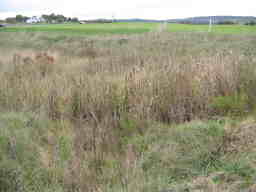 |
Wetlands A-Z Book The Discover America State by State series (from
Sleeping Bear Press) uses images, rhymes and engaging text to explore a state's history, culture and interesting facts. The books
unfold in alphabetical order. A is for ... |
 |
The alphabet books seem simple, but actually represent quite a challenge to develop.
Create an alphabet fact book about wetlands and the organisms that live in the wetland habitats. Focus on wetlands in your region. You could opt to really challenge yourself by focusing on a sub subject like wetland plants, mammals, amphibians or birds. The larger the area or the broader the subject you cover in the project, the easier the project is likely to be. Employ creative thinking in order to use every letter of the alphabet.
Tip: Begin by brainstorming words related to wetlands. This list will help you get started. A thesaurus, a glossary in a book about wetlands ecology, and websites about wetlands can be handy resources for "finding" words and information.
1. Gather the letter > word and their facts.
2. Write the prose. Include a fact filled paragraph about the word for each letter. Love a Challenge? Connect that word's fact to the next letter or another letter in the project.
Example: In a family book J is for Jen. She is a special person. She likes horses and dogs. She is an outstanding student. Jen says she always works for A's. She is studying to be a lawyer. Jen is also working hard at THON because she is a very Kind Person. K is for Kind
3. Make it an online book in a web site so that you can share your creation with your community.
See these examples: Morris Farm Alphabet Book or Best Treat of All
1.
Make a new folder called wet your initials. Example: wetco.
Save all your web pages into the wet folder.
Each web page should be one letter. Name each page based on the letter. Example a.html, b.html
2. In your wet folder - make another folder to hold your images. Call it "images".
Place your image files in the image folder BEFORE adding them to the web pages.
3. Link the pages in order A .. Z to allow an easy read through.
You can use words like "Click here to go to the next page" to link to the next page.
Consider using arrows
pointing to the right
to show people how to go to the
next page.
Link the arrow image to make the connection to the next page.Techie tip: You could add an alphabet links to the bottom pf the page to make navigation easier. A | B | C ...
Make the A | B | C list on the a.html page. Link each letter to the correct page. Then copy the list. Paste it on the rest of the pages. :-)
4. Make a Main Title Page that includes credits and a linked index that allows visitors to go to a specific letter.
5. Make your own illustrations using a computer or use free web images to add pictures. Take digital photos in your community. Alternatively, you can scan in hand drawn art. Be sure to save them into your images folder. Then add them to your web page. You have my permission to use these wetlands photos in a student project Photo 1 | Photo 2 | Photo 3 | Photo 4
Resources: How to make web pages: FrontPage | TextEdit or SimpleText | NotePad | Netscape's Composer 7.x or Atomic Learning | Webmonkey for Kids | Word's Web Page Wizard | Basic elements of Web page design | Dreamweaver & FrontPage | Web development tutorials | Word tutorial
Software tutorials - Photoshop, Pagemaker, Dreamweaver & more | LearningElectric - on demand tutorials that build skills
Copyright friendly images for use in education projects Wikimedia Commons | Pic4Learning | Public Domain images links
Example of a children's book online - Biomes and Ecosystems | Simple A- Z book The Anti Slavery Alphabet 1847
![]() Wetlands: Habitat / Mammals / Birds / Macrovertebrates - Aquatic Insects / Plants & trees / Amphibians / Conclusions
Wetlands: Habitat / Mammals / Birds / Macrovertebrates - Aquatic Insects / Plants & trees / Amphibians / Conclusions
PA Environment and Ecology Education / Environmental Careers / Make a schematic representation
Nature / Milkweed & Monarch Butterfly Mania / Bluebirds Project / Fields, Fencerows & Meadows EcoStudy Unit
Internet Hunts / Computers / Plants and People / School Habitat Garden Project / Puzzles & Projects / Pennsylvania Projects / Home
posted by Cynthia
J. O'Hora , 2/2009
In honor of Tatiana Garcia-Granados's work at East Park Revitalization Alliance, released to be freely used by not for profit agencies and schools
Working in a group or in two different places like the library & home? You do not have to be physically together to work together. ![]() Watch Google Docs video TAI - How could you use Google Docs to do a project? How would this facilitate group projects?
Watch Google Docs video TAI - How could you use Google Docs to do a project? How would this facilitate group projects?
Aligned with the following Pa Academic Standards - Reading, Writing Speaking, Ecology & Environment, Mathematics, Arts, Science and Technology